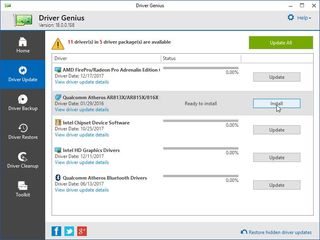
If the values are stored in the EEPROM afterwards, there should hardly be any problems with a clean first print layer. In addition to a wizard for manually aligning the print bed, all sorts of settings and auto-bed leveling can be called up here.īefore you start the first print, you should run the Auto-Bed-Leveling and then set the Z-offset with the help of the wizard. The individual menus on the touchscreen provide a good overview and offer a variety of functions.
#Drive genius 4 reviews pro#
The Artillery Genius Pro can be supplied with instructions via USB connection or touchscreen. While no disadvantage of the construction can be seen in the test, the question arises whether the large plastic part will also remain stable in the long run. The upper crossbar is also made of plastic. Here, only a rectangle of 40 mm × 40 mm (~1.6 in x 1.6 in) profiles was used. In the base, the amount of stabilizing aluminum profiles is limited. This means that you would have to loosen and move the attachments of the deflection pulleys if you want to retighten the drive belts of the two axes. However, belt tensioners on the deflection rollers of the X and Y axes are completely missing here. The Z-axis is also driven by two motors and threaded spindles that are synchronized on the upper crosshead by means of a toothed belt. Artillery also goes its own way with the rollers of the Z-axis and ensures an optimal contact pressure by means of springs. This should provide better stability than, for example, the Voxelab Aquila S2. The print head runs on a particularly high 60 mm × 20 mm (~2.4 in x 0.8 in) profile. The Artillery Genius also uses many V-Slot aluminum profiles, but the 3D printer has a few special features. All small parts are packed in a fabric bag with a zipper. In the scope of delivery of the 3D printer, Artillery also puts 500 grams (~18 oz) of PLA filament and some spare parts, as well as another nozzle in the box, in addition to the tools necessary for assembly. The Genius Pro can also be disassembled just as quickly if you want to store the printer in a space-saving way. Thus, the assembly of the 3D printer takes less than 10 minutes in our case, considering the unpacking of all components from the box. The connector is apparently a misused PCIe slot. Otherwise, the large adjustment nuts of the print bed could scratch the cables.Īll other connections to the X-motor and printhead are already made via a plug-in contact when the gate is assembled. For the two cables of the Z-motors, however, you should make sure to lead the cables back into the housing as far as possible. Once these are plugged in, the 3D printer can already be put into operation.

The missing electrical connections are three cables. The filament roll holder is then plugged together. To assemble it, all you need to do here is put the archway on the base and screw in the four pre-attached screws. The actual Genius Pro is disassembled into a base unit and an archway. The entire 3D printer is delivered by Artillery in just six individual parts, four of which are the filament roll holder.


 0 kommentar(er)
0 kommentar(er)
